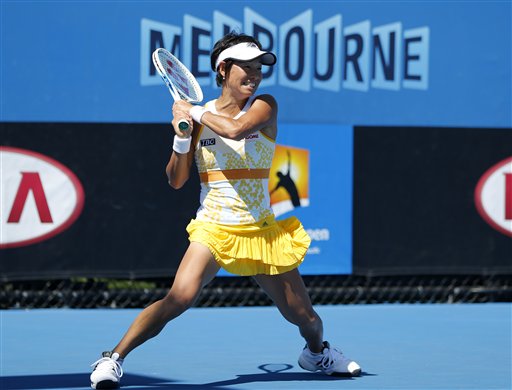
Kimiko Date-Krumm of Japan makes a forehand return to Belinda Bencic of Swtizerland during their first round match at the Australian Open tennis championship in Melbourne, Australia, Monday. AP
MELBOURNE, Australia—Kimiko Date-Krumm is used to questions about retirement but still has no answer. For now, she’s content to continue the “miracle” of playing professional tennis at age 43.
She is also used to the distinction of being the oldest women’s singles player at Grand Slams. On Monday, the veteran was matched against the second-youngest player in the draw, 16-year-old Belinda Bencic, a qualifier playing in her first major after winning two junior Grand Slam titles last year.
Bencic eliminated Date-Krumm in the first round, 6-4, 4-6, 6-3, after a nearly two-hour match under a hot sun that left the veteran exhausted.
“I felt so tired. I had no power. I tried not to do long rallies because she never made a mistake,” Date-Krumm said after the match in a good-natured session with reporters who kept asking how much longer she can play on.
“Already, it’s a miracle,” she joked, adding, “I’m still enjoying playing. I’m still enjoying playing Grand Slams, also. So, keep fighting.”
“I don’t know how many years, how many months.”
When she thinks about life after tennis, she imagines relaxing more and not traveling so much and spending more time with her husband, German race car driver Michael Krumm.
Maybe one day she’ll wake up and just decide it’s time.
“Maybe tomorrow,” she laughed. “Maybe tonight. Or maybe five years later. I don’t know.”
This was Date-Krumm’s 47th time playing a Grand Slam tournament—and she was the oldest woman in the draw by a decade. The only other players who came close were were 33-year-olds Venus Williams, who also lost in the first-round, and Francesca Schiavone, who plays Tuesday.
The 80th-ranked Date-Krumm has won eight career titles and reached the Australian Open semifinals in 1994. She was once Asia’s highest-ranked player, having peaked at No. 4 in 1995—two years before Bencic was born. The Asian record is now No. 3 and is held by Li Na, who faces Bencic in the next round.
Date-Krumm took a 12-year break from tennis and returned in 2008.
Since her comeback, she has failed to advance beyond the third round of a Grand Slam. But she continues to amass “oldest player” records. Among them, at 39, during the 2010 French Open, she became the oldest player to beat a Top 10 player. She then beat her own record later that year in Osaka after turning 40.
On Monday, Date-Krumm was 27 years older than her opponent, the largest age gap since 47-year-old Martina Navratilova lost to 19-year-old Gisela Dulko at the 2004 Wimbledon.
But the numbers that mattered Monday were the ones on the scoreboard.
Date-Krumm started the match with a 3-0 lead and then lost momentum as the 187th-ranked Bencic rallied back with a break and won the last four games of the first set.
Date-Krumm battled back in the next set, prompting Bencic to bounce her racket in frustration after one flubbed point.
Bencic took control in the third, as Date-Krumm wilted with temperatures rising.
“I needed to take more risks and hit down the line, but (I had) not enough power, not enough control, not enough everything,” she said. “But she didn’t change anything. (She kept the) same level.”
“When I was fighting with her, she didn’t look like a high school girl,” Date-Krumm added, laughing.
Bencic did look her age as she was ushered into the main press conference room at Melbourne Park, where an amphitheater full of reporters asked what it felt like to win her first Grand Slam match.
“I was a little bit nervous in the beginning,” Bencic said, shyly. “Yeah. I don’t know. It was special.”
The teenager, who has been coached by Martina Hingis’ mother, Melanie Molitor, is seen as one of the game’s potential rising stars. She won two junior Grand Slam titles in 2013 at the French Open and Wimbledon.
Bencic’s match Monday was out on Court 6 but she’s hoping for better billing against Li Na.
“It will be tough, but (it) will be nice experience for me. Hopefully on a big court.”

